PDO News
November 23rd, 2015
Posted in PDO News
Peter published a paper in Philosophical Transactions on the physics of stratum corneum lipid membranes, together with Chinmay Das from the University of Leeds. The paper is part of the proceedings of a Discussion Meeting on “‘Soft interfacial materials: from fundamentals to formulation”, held at the Royal Society in London, in October 2015.
In The stratum corneum (SC), the outermost layer of skin comprises rigid corneocytes (keratin-filled dead cells) in a specialized lipid matrix. The continuous lipid matrix provides the main barrier against uncontrolled water loss and invasion of external pathogens. Unlike all other biological lipid membranes (such as intracellular organelles and plasma membranes), molecules in the SC lipid matrix show small hydrophilic groups and large variability in the length of the alkyl tails and in the numbers and positions of groups that are capable of forming hydrogen bonds. Molecular simulations provide a route for systematically probing the effects of each of these differences separately. In this article, we present the results from atomistic molecular dynamics of selected lipid bilayers and multi-layers to probe the effect of these polydispersities. We address the nature of the tail packing in the gel-like phase, the hydrogen bond network among head groups, the bending moduli expected for leaflets comprising SC lipids, and the conformation of very long ceramide lipids in multi-bilayer lipid assemblies. In their paper, they argue that the line tension they have calculated explains domain registration between leaflets, with no need for the direct (area-dependent) inter-leaflet coupling often considered. We show that this is not quite correct and that one needs to consider the entire line energy for given composition(involving the length of interface) in order to predict equilibrium states. When this is done properly, one tension alone does not in general explain equilibrium domain registration.

PDO News
November 23rd, 2015